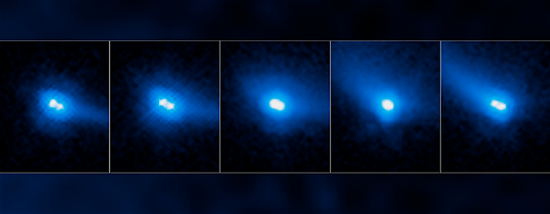
Asteroid 300163 (2006 VW139) Credit: NASA, ESA, and J. Agarwal (Max Planck Institute for Solar System Research).
Sep 6, 2018
Intense electric fields most likely create comets out of asteroids.
Just before asteroid 300163 (2006 VW139) came closest to the Sun in September 2016, an image from the Hubble Space Telescope displayed a peculiar detail: it is a pair of objects 60 miles apart that are orbiting one another.
Space scientists routinely examine small planetoids called Near Earth Objects (NEO), because there are concerns about large rocks striking Earth. The prevailing theory about dinosaur extinction suggests that an NEO was responsible for a global cataclysm, altering the course of evolution. It is thought that Earth was struck by asteroids and comets many times in the past, so astronomers closely examine NEOs to see if any of them cross Earth’s orbit.
About 15% of all asteroids are pairs. Such celestial doublets are said to result from sunlight causing an asteroid’s spin-rate to increase. Since asteroids are thought to be loosely compacted “rubble piles”, increased angular momentum forces the rocky conglomerate apart, forming another rubble pile in orbit about the first. What makes 300163 (2006 VW139) unique is that the binary asteroid displays cometary behavior.
The rubble pile theory is used to explain mass anomalies that are seen in asteroid crater studies. Some asteroid craters are so large that the asteroid, itself, should no longer exist, the impact should have blown it into fragments. Considering asteroids like Mathilde, where one third of a hemisphere is missing, why it remains intact is a mystery. The conventional explanation is that asteroids are loosely compacted. When they are hit by something, they respond like big piles of sand, absorbing the impacts—there is no hard crust, so they do not fracture.
Electric Universe theory does not require collisions for craters to exist: electric arcs can erode surfaces, scooping out material and accelerating it into space. Clean cuts, deep pits and chaotic topography are left behind. Comets also exhibit features that are seen on asteroids, leading to an idea that they are really one thing and not “dirty snowballs” vs. loose, rocky bodies. That electrical effect can explain the doubling phenomenon, as well.
If electrical stress becomes too great within an asteroid—when it enters an electrically charged planetary magnetosphere, for instance, it might explode into tiny fragments and burn-up. If electrical stress is not too great as an asteroid flies through an electric field, it might split into two large pieces instead of exploding, equalizing potential by spreading it over a larger surface area, leaving orbiting twins that continue on their way.
A theory of electrical fissioning might provide a more reasonable hypothesis than sunlight and angular momentum.
300163 (2006 VW139)’s cometary tail is another mystery for astrophysicists. On December 11, 2010 asteroid 596 Scheila formed a coma, along with two dusty tails trailing behind. Since no water vapor thought to be “normally” associated with comets was detected, the 18,000 kilometer per hour impact of an “unknown” 30 meter diameter body was suggested as the source for the dust plumes.
Electric Universe advocate Wal Thornhill takes issue with the water vapor presumption, however, pointing out that the snowball theory of comets is off the mark:
“The flaw in the conventional approach is that only gas-phase chemical reactions and reactions induced by solar radiation (photolysis) are considered. The far more energetic molecular and atomic reactions due to plasma discharge sputtering of an electrically charged comet nucleus are not even contemplated…The hydroxyl radical, OH, is the most abundant cometary radical…It is chiefly the presence of this radical that leads to estimates of the amount of water ice sublimating from the comet nucleus.”
As mentioned in a previous Picture of the Day, several “Centaur objects” are located near the asteroid belt. 2060 Chiron is classified as both comet and asteroid. Chiron manifests a coma whenever it reaches its closest approach to the Sun, although it does not grow a tail. 174P Echeclus displayed a coma in 2005, so it is classified as a cometary asteroid. At least ten Centaurs are known to have cometary activity at great heliocentric distance. This belies the current understanding that solar heating causes comas and tails.
Asteroids and comets exist in a continuum: neither are strictly identical nor completely different from the other. For example, when the Stardust mission collected samples from the coma of comet Wild 2, scientists found that the material looked like meteoric dust instead of ejecta from a snowy dirtball. No “jets” of water vapor spew from comets, and no icy plains are observed. It is electric effects that are seen. Discharges and arcs form the comet/asteroid phenomenon.
Stephen Smith












